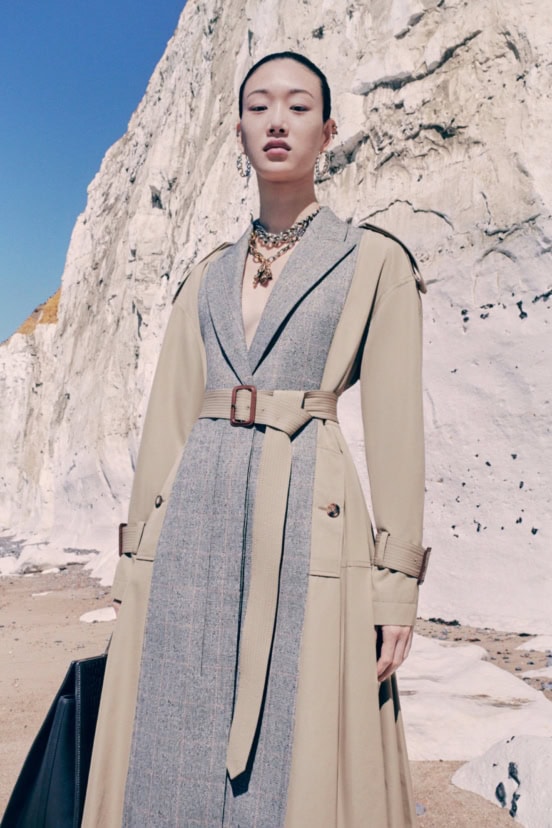Review of Alexander McQueen Pre-Spring 2021 Fashion Collection
Baring to the Essence
By Long Nguyen
“This collection was designed during the lockdown. It is made predominantly out of stock fabric: over-printed, over-dyed – renewed,” was the statement made upon the release of the Alexander McQueen Pre-Spring 2021 collection that marked a stark difference in terms of the usual complex and artistic inspiration that Sarah Burton drew for each of her seasonal shows in Paris.
Now all the momentous travels and historical inspirations – like the visit to Wales and the Celtic land of myths and the Wrexham Tailor’s Quilt at the St. Fagans National Museum of History in Cardiff that spawned the heroic patchwork clothes of upcycle materials from Fall 2020, or the sisterhood garments from Spring 2019 based on the standing stones of Avebury – a circle of stones thought to be older than Stonehenge, or the spectacular garden of the Great Dixter house in East Sussex that brought embroidered floral dresses or the landscape of Cornwall in the southernmost county in the UK that hand ribbons embroidered dresses – seemed so distant during the period of national lockdown in this late spring.
With just old fabrics, Burton put her design mind to work and work ceaselessly on each of the garments in this quintessentially Alexander McQueen signature wardrobe, the signature style she created and evolved over these years.
The collection is grounded in this new reality. The firm aesthetic that Sarah Burton has imbued her Alexander McQueen’s collections in the near-decade has steered the brand creatively.
This collection is the building blocks – the signature fashion looks that are often evasive in many of the luxury collections today – that Burton had always done at McQueen when the runway decorations were taken away to show the great tailoring, the great square and sweetheart necklines full dresses and the outerwear which now consists mainly of light trench coats in beige twill.

Burton is a textile specialist – that was her area of study at Central Saint Martin – and research in fabrics was part of her work when she first joined Lee McQueen. Here in this collection, Burton refashioned out of stock and old fabrics and repurpose them for a new life like the process of reusing white silk in the dress with a deep open neckline and twisted draped skirt in washed silk taffeta now an uneven dip-dyed in albion pink, fuschia rose, and lust red or in a dress with a draped knotted asymmetric bodice in washed silk organza dip-dyed pink rose, fuschia rose and dahlia with the light pink corset and stiffened tulle underskirt. Other standouts are the light blue trapeze line dress with puff sleeves and asymmetrical tiered hem with a Trompe-l’œil print of 1950’s photographic rose and Victorian lace in white cotton poplin and the red cotton silk rose print draped sweetheart neckline dress.

However, the real strength of this collection lies in the meticulous and masterful tailoring work on the slim, lean, and straight-line cuts of the pantsuits with the primary focus on the single breast jacket with a strong men’s shoulder and variations on the deconstructed lapel detailing like an overlay cut out lapels or underlay crossover flaps lapels, a slight hip line at the waist, and straight cut cigarette pants falling to the toe level. One wool tuxedo jacket has a cut out back, and an extended shawl collar drape in ivory wool silk resembles a scarf at the front, and another black wool tuxedo jacket has a wrapped bow peplum in pink silk sewn into the front and around the waistline. Following the notion of reworking the old fabrics to make a new material, a single breast wool-silk jacket and cigarette pants are dip-dyed in pink, rose, and a dahlia from top to bottom a tiered color effect.
Elsewhere the tailoring work can be seen in the slim fitted trench coats with a few different versions – a beige pleated back trench with a single breast coat front lapel, a deep navy hybrid trench with distressed jacquard Prince of Wales check in the back, and as trench dresses such as the light ivory cotton with exploded and open neckline collar or the black silk faille with boat neck and a flare cut. Even the evening gowns are kept to a minimal shape devoid of any embellishments. A men’s white shirt paired with black pants with bow peplum is sufficiently formal.

This collection is simply a step forward for Sarah Burton and the Alexander McQueen brand both aesthetically and commercially. It is not an everyday thing that the clothes themselves can bring about the understanding of a seasonal collection and a brand.
Perhaps this is the most difficult task for any designer to let the clothes do the talking and not the accouterments borrowed from the arts or taken from the style of another era like the 1970s or 1980s that often surrounded and drowned out the clothes with little design honesty.
